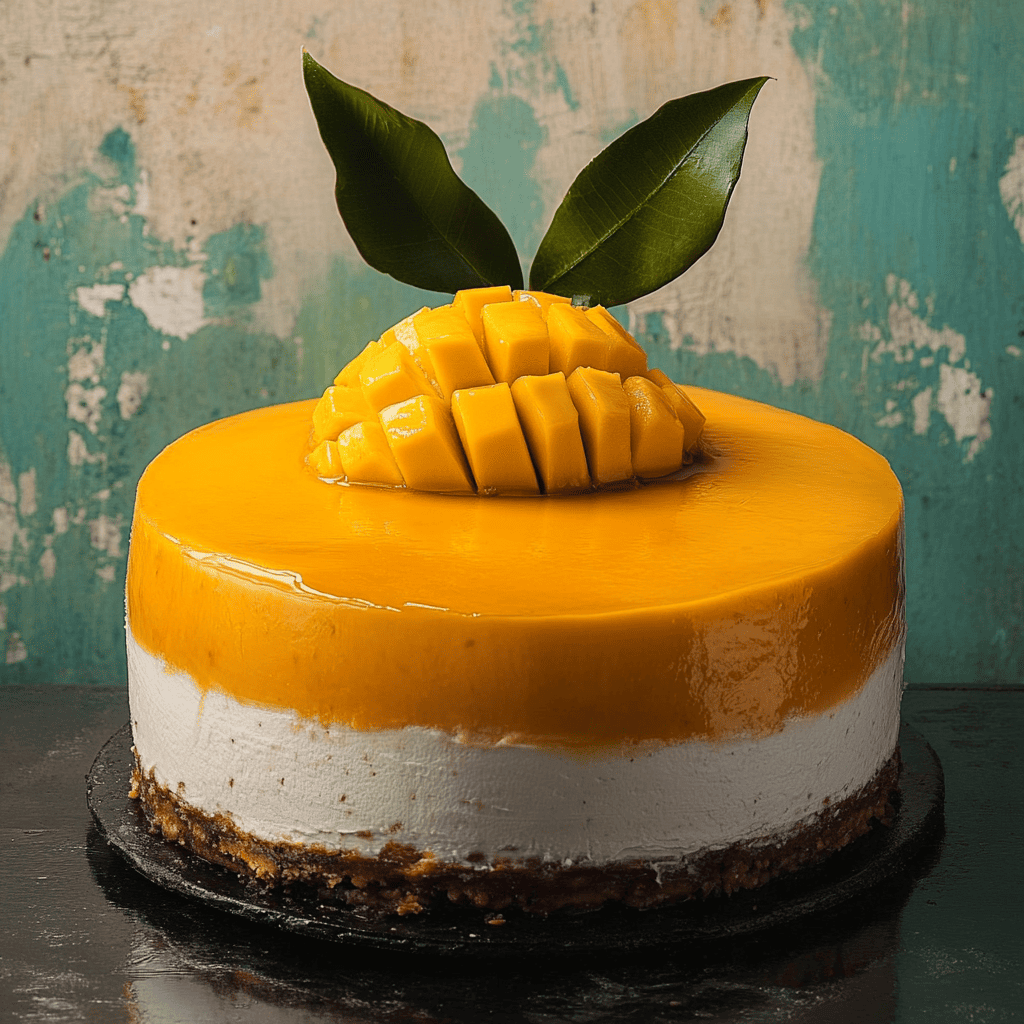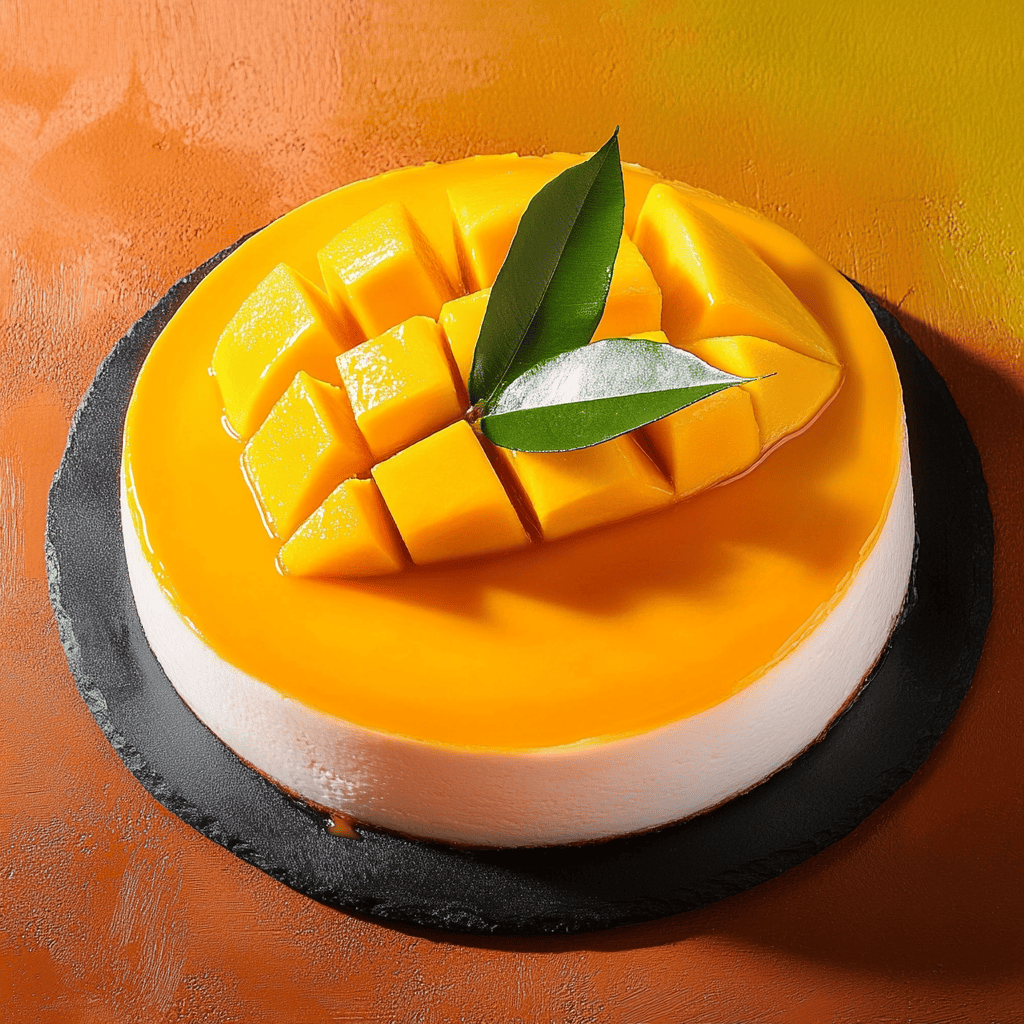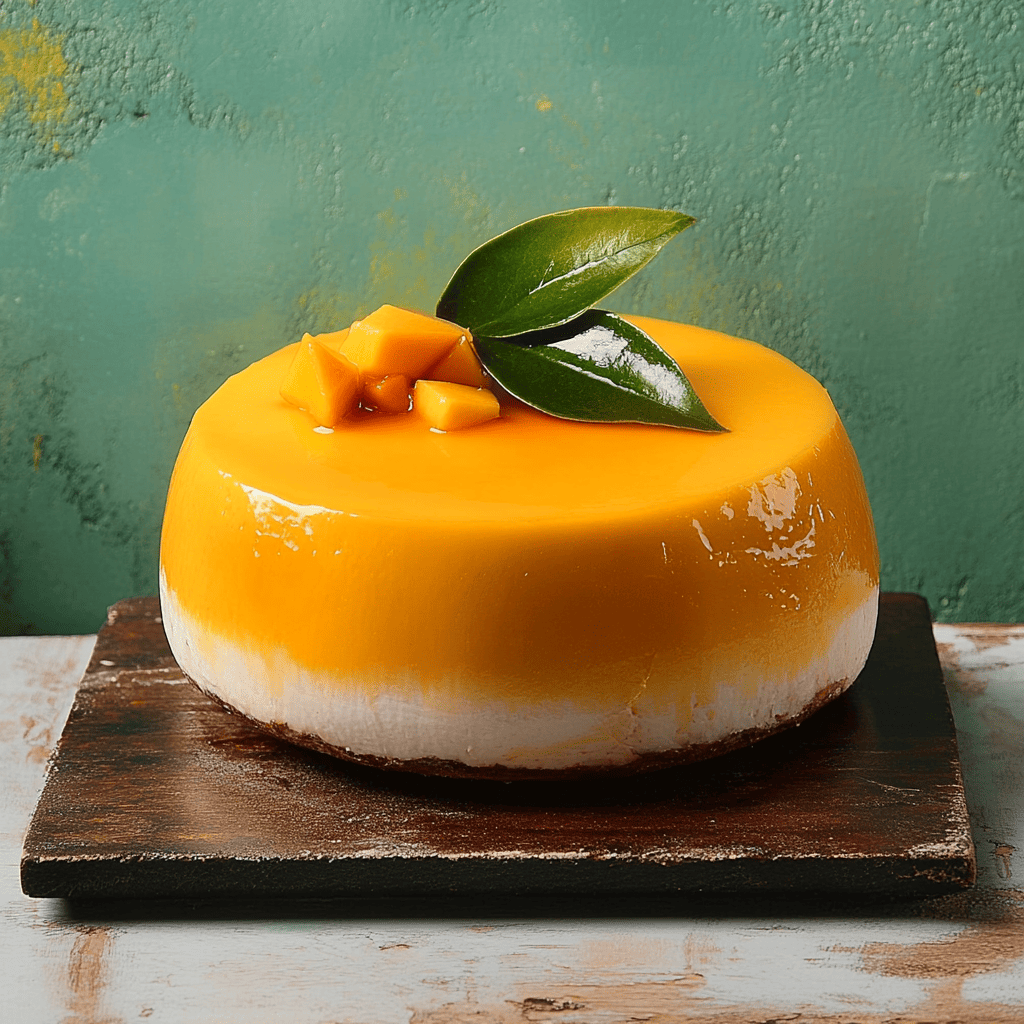Cold Mango Pie
Introduction
Cold mango pie is a refreshing, creamy, and easy-to-make dessert, ideal for hot days. Its combination of a crispy biscuit base with a smooth filling of cream cheese, condensed milk, and mango makes it an irresistible delight. In this exposé, we’ll explore its history, the necessary ingredients, detailed preparation, and some tips for achieving the best result.

A. History and Origin of the Cold Mango Pie
Cold pie is a variation on classic cheesecakes or cold no-bake tarts, which have their origins in European pastries, especially in Germany and the United States. Over time, these recipes have been adapted in Latin America, incorporating local ingredients such as mango , a tropical fruit prized for its sweetness and texture.
The Ataúlfo mango , native to Mexico, is one of the most popular varieties for desserts due to its soft flesh and sweet flavor. Its combination with dairy ingredients and the firm texture provided by gelatin make cold mango pie a fresh and delicious dessert.
Origins of Cold Pie
Cold pie is a variation on the classic no-bake cheesecake . This type of dessert has its roots in Europe, especially in Germany and Greece, where cold cakes with cheese and honey have been made since ancient times.
As baking evolved, the idea of making pies without an oven became popular in the United States during the 20th century. With the invention of packaged cream cheese and the ease of mixing ingredients while cold, multiple versions of refrigerated pies and cheesecakes emerged.
Mango in Gastronomy
The mango is one of the most prized tropical fruits in the world and has a fascinating history. Its origin dates back more than 4,000 years to India , where it was considered a symbol of prosperity and abundance. With the expansion of trade routes, the mango reached Africa, Southeast Asia, and eventually the Americas.
In Mexico , the mango has adapted perfectly to the country’s warm and fertile climate. Today, Mexico is one of the world’s leading mango producers. Among the most famous varieties is the Ataúlfo mango , distinguished by its sweet, fiberless flesh and creamy texture, making it ideal for desserts like cold mango pie .
The Fusion of Cold Pie and Mango
The incorporation of mangos into desserts like cold pie is a reflection of the creativity of Latin American cuisine. Mexico, with its abundance of fresh mangoes and its tradition of cold desserts, adapted the classic cold pie recipe to incorporate this delicious tropical fruit.
Cold mango pie became popular in homes and bakeries for its ease of preparation and refreshing flavor. Unlike other pies that require baking, this pie is perfect for warm climates, as it’s prepared without an oven and can be stored refrigerated.
Its success lies in the combination of three key elements:
- Crispy biscuit base , which provides texture and contrast.
- Creamy filling , made with cream cheese, condensed milk and yogurt, which balances the sweetness of the mango.
- Fresh mango chunks , adding a tropical flavor and a richer sensory experience.
Popularity and Evolution
Today, cold mango pie is a typical dessert in many Mexican and Latin American homes, especially during warmer weather. It has evolved with variations that include ingredients such as coconut milk, whipped cream, mango jelly, or nuts to give it a special touch.
Today, this dessert is not only popular in Latin America but has also been adopted in other countries, especially those where mango is a common fruit. Thanks to its ease of preparation and exquisite flavor, cold mango pie has become a classic among tropical pastries.

B. Ingredients of the Cold Mango Pie
For the base:
- 1 package of Maria cookies
- 1 stick of unsalted butter
For the filling:
- 1 cream cheese (approximately 190 g)
- 1 can of condensed milk (lechera)
- 1 cup of natural yogurt
- 1 lemon (its juice)
- 1 cup of Ataulfo mango (for blending)
- 2 cups of diced mango (to add to the filling)
- 1 ½ sachets of gelatin (each sachet is 7 g)
- 3 tablespoons of water
C. Step-by-Step Preparation
1. Base Preparation
- Grind the Maria cookies in a blender or food processor until you get a fine powder texture.
- Melt the butter in the microwave or in a small saucepan.
- Mix the melted butter with the ground cookies until a homogeneous dough forms.
- Line the bottom of a mold with this mixture, pressing down firmly with a spoon to compact it.
- Refrigerate the crust for at least 20 minutes to firm up before adding the filling.
2. Preparation of the Filling
- Hydrate the gelatin in the 3 tablespoons of water and let it sit for 5 minutes until it absorbs the liquid.
- Microwave the gelatin for 10-15 seconds until completely dissolved.
- In the blender, mix the cream cheese, condensed milk, yogurt, lemon juice and 1 cup of Ataulfo mango.
- Add the dissolved gelatin to the mixture and blend for a few more seconds until you obtain a homogeneous mixture.
- Pour the mixture into a bowl and add the 2 cups of diced mango , stirring gently to distribute evenly.
3. Assembly and Cooling
- Empty the mixture onto the already chilled biscuit base.
- Spread evenly and gently tap the mold on the table to remove air bubbles.
- Refrigerate for a minimum of 4 hours or until the pie is completely firm.
D. Tips for a Better Result
- Creamier texture: For a softer pie, you can add half a cup of whipping cream before blending.
- More mango flavor: If you want a more intense flavor, you can add mango pieces as decoration on top.
- Natural sweetener: If you prefer a less sweet dessert, you can substitute part of the condensed milk with honey or evaporated milk .
- Firmer base: To prevent the cookie base from crumbling when serving, you can add 1 tablespoon of sugar and a little more butter .
- Best served: Garnish with mango slices, mint leaves, or lemon zest just before serving.
Questions about Mango Cold Pie
History and Origin
- What is the origin of cold pie and how does it differ from baked cheesecake?
- When and how did the mango arrive in America and why is it so popular in Mexico?
- How has the recipe for cold pie evolved in different cultures?
Ingredients and Techniques
- Why is gelatin used in the preparation of cold mango pie?
- What role does natural yogurt play in the texture of the filling?
- What other tropical fruits can be used instead of mango to make a cold pie?
- How can you make a dairy-free version of this recipe?
Preparation and Variations
- What techniques can be used to achieve a crispier, firmer cookie base?
- How can you make the filling thicker without changing the flavor of the mango?
- Can other ingredients, such as shredded coconut or almonds, be added to give it a special touch?
- What presentation is recommended to make the cold mango pie look more attractive?
Culture and Tradition
- At what holidays or events is it most common to serve cold mango pie in Latin America?
- How does cold mango pie compare to other popular cold desserts in the region?
- What impact have social media and food trends had on the popularity of this dessert?
Additional Information about Mango Cold Pie
Recipe Variations
- Sugar-free version: You can substitute condensed milk with evaporated milk and sweeten with honey or natural sweeteners.
- Gluten-free version: Use gluten-free crackers for the base.
- Vegan version: Replace the cream cheese with almond cheese or soft tofu, the condensed milk with condensed coconut milk, and the gelatin with agar-agar.
- Fruitier version: You can add chunks of strawberry, kiwi, or pineapple to the filling for a more tropical flavor.
Tips for a Better Result
- Refrigerate the pie overnight for a firmer, creamier texture.
- Garnish with fresh mango slices and mint leaves before serving for a more attractive presentation.
- Use very ripe mangoes to intensify the sweet, natural flavor of the dessert.

E. Conclusion
Cold mango pie is a delicious, refreshing, and easy-to-make dessert, perfect for any occasion. Its combination of crispy crust , creamy filling , and natural mango chunks make it an irresistible choice for tropical dessert lovers.
Plus, it’s a versatile recipe that can be adapted to suit personal tastes, incorporating other ingredients such as shredded coconut, nuts, or even a layer of mango jelly for a more sophisticated finish.
This pie is not only a great way to enjoy mangoes at their peak season, but it also represents a tradition in Latin American home baking. Its easy preparation makes it ideal for both novices and baking experts looking for a quick and delicious dessert.
Ultimately, making a cold mango pie is a simple and satisfying experience that allows us to enjoy a fresh, natural dessert full of tropical flavor. A classic that never goes out of style!

